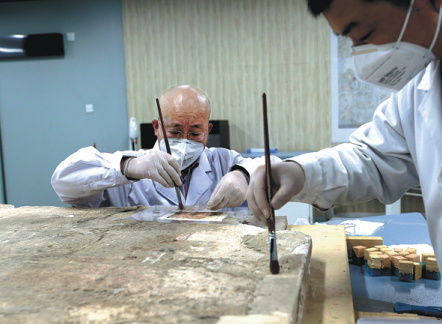source: editor:张悦

Technicians restore an ancient fresco at the Shaanxi History Museum in Xi'an, Shaanxi province. ZHANG YUAN/CHINA NEWS SERVICE
XI'AN-While standing in a damp and moldy tomb, Yang Wenzong felt overwhelmed as he gazed at the murals that date back more than 1,200 years.
Despite the decay, the colors and lines of the frescoes were still recognizable, but some of the delicate paintings were incomplete due to theft and destruction by tomb raiders.
Yang and his team were conducting a salvage excavation in the 12-meter-deep tomb of Han Xiu, a well-known chancellor during the Tang Dynasty (618-907).
After preparation work, Yang used a brush to delicately reinforce and repair the incomplete paintings.
Since graduating from Northwest University in 1984, Yang, 58, has devoted himself to the protection and restoration of cultural relics. To him, cultural relics are like elderly patients and he is a doctor who treats them.
"The restoration of a tomb's murals starts by transferring them," Yang said. "Most of these paintings, like elderly patients, produce 'symptoms' including cracking and mildew, so a process of reinforcing is needed before conducting an 'operation'."
Restoring tomb murals is time-consuming and meticulous work.
A breeze or a bright light can cause damage to the murals. Some ancient tomb frescoes are well-preserved, but the cement materials used in the paintings becomes decomposed after thousands of years.
"Even a slight breath may cause the pigments to fall off, as the dyes are attached to the surface of the murals in the form of powder," he said.
Yang and his colleagues conducted thousands of trials and gradually formed what is now considered an industry standard in the protection and restoration of tomb frescoes.
The restoration of the Han Xiu tomb, which began in 2014, is an example of the country's heritage conservation experts trying to protect murals in a scientific and systematic way.
It took nearly two years to transfer the murals, and restoring them fully will take even longer; some are still being repaired.
"It's a profession that requires a great deal of patience and endurance," Yang said, adding that a single movement can be repeated thousands of times to remove dirt from a fresco without damaging a layer of paint.
Over the past three decades, Yang has renovated thousands of cultural relics, including ancient murals, bronzes, ceramics, porcelain, and gold and silver wares.
Many of them are big names. He participated in the work on the Bronze Chariot and Horse No. 2 unearthed in the mausoleum of Emperor Qinshihuang, world-renowned for the Terracotta Warriors.
Yang frequently walks around the exhibition hall of Tang Dynasty mural paintings that are on display in the Shaanxi History Museum.
The underground hall houses nearly 100 exhibits unearthed from the imperial tombs and the tombs of nobles. Yang has been involved in the restoration of many of the items.
"We are 'relic doctors'. When you realize what you are rescuing is priceless, a sense of accomplishment emerges," Yang said.
"Nothing else can replace that feeling."